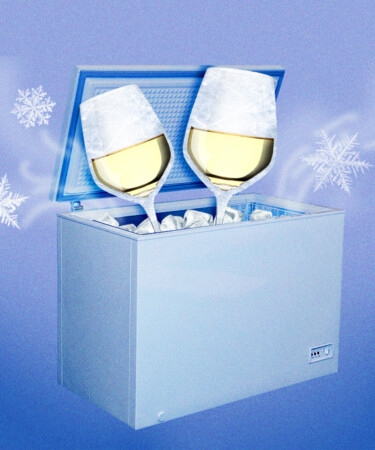There’s nothing quite like drinking an ice-cold Martini out of a freshly frosted glass. So if sipping gin or vodka out of cold stemware feels like such a luxury, why don’t we do the same with wine? Is serving poolside rosé or toasting Champagne in a chilled glass the ultimate summertime hack? Or would it ruin the entire tasting experience? VinePair asked Kaori Yoshioka, head sommelier and restaurant manager at Miami’s Michelin-starred omakase restaurant SHINGO, to help tackle these burning questions.
While cocktails like the Martini usually taste best as cold as possible, each type of wine thrives at a different, very specific serving temperature. So in order to ensure an optimal experience, the wine itself is usually kept at the ideal temperature rather than relying on the stemware to do the work. Storing the bottle in a fridge or cellar keeps the chill consistent and predictable, as opposed to the quickly waning frost of a glass.
Pouring your favorite Sauvignon Blanc or Chardonnay into a pre-cooled glass could render the wine too cold, which doesn’t usually help its flavor profile. “When wine is too cold, it masks the flavor and sometimes it can taste thin and harsh,” Yoshioka says. She adds that chilling a glass could result in condensation, diluting the wine and further mellowing out its characteristics. So that Sancerre known for its delicate citrus notes, hints of green herbs, and minerality might end up tasting like a generic, watered-down white.
If a guest specifically asks for a chilled glass, Yoshioka says she would be happy to help them, but would explain that “while this might prevent the wine from warming up quickly, there may be unwanted side effects on flavor and aroma as well.”
With its lower alcohol content and more nuanced flavors, wine is more sensitive to these subtle variations than spirits. That’s why so many wine pros and enthusiasts are so picky about stemware or even insist on bringing their own glasses to a restaurant. If you’re opening a high-end bottle that you really want to savor, it’s best to keep the wine in a pristine glass. Plus, high- quality wine glasses are usually razor-thin, making them more difficult to toss in the fridge than your average pint glass.
That said, if you’re looking to enjoy an unfussy wine by the pool and aren’t too concerned with taking tasting notes, throwing a few thick, stemless glasses in the freezer for a few minutes ahead of time to keep the wine as cool as possible for as long as possible, we’re not going to stop you.
*Image retrieved from REDAV via stock.adobe.com
